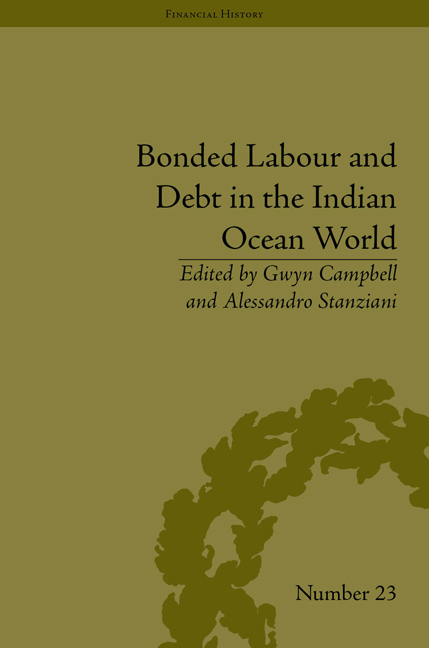Book contents
- Frontmatter
- Contents
- Acknowledgements
- List of Contributors
- Introduction
- 1 Debt and the Coercion of Labour in the Islamic Legal Tradition
- 2 Debt, Pawnship and Slavery in Nineteenth-Century East Africa
- 3 Debt and Slavery in Imperial Madagascar, 1790–1861
- 4 Credit and Debt in the Lives of Freed Slaves at the Cape of Good Hope: The Case of Arnoldus Koevoet, 1697–1735
- 5 Debt, Labour and Bondage: English Servants versus Indentured Immigrants in Mauritius, from the Late Eighteenth to Early Twentieth Century
- 6 Ransom, Escape and Debt Repayment in the Sulu Zone, 1750–1898
- 7 Debt and Slavery among Arabian Gulf Pearl Divers
- 8 The Political Economy of Debt Bondage in Contemporary South India
- 9 The Name of the Slave and the Quality of the Debt: When Slaves Are Not Debtors and Debtors Are Not Slaves in the Family Narrative of a Filipina Comfort Woman
- 10 Two Bonded Labour Emigration Patterns in Mid-Nineteenth-Century Southern China: The Coolie Trade and Emigration to Southeast Asia
- 11 Debt Slaves in Old Korea
- 12 The Debt-Servitude of Prostitutes in Japan during the Edo Period, 1600–1868
- Notes
- Index
4 - Credit and Debt in the Lives of Freed Slaves at the Cape of Good Hope: The Case of Arnoldus Koevoet, 1697–1735
- Frontmatter
- Contents
- Acknowledgements
- List of Contributors
- Introduction
- 1 Debt and the Coercion of Labour in the Islamic Legal Tradition
- 2 Debt, Pawnship and Slavery in Nineteenth-Century East Africa
- 3 Debt and Slavery in Imperial Madagascar, 1790–1861
- 4 Credit and Debt in the Lives of Freed Slaves at the Cape of Good Hope: The Case of Arnoldus Koevoet, 1697–1735
- 5 Debt, Labour and Bondage: English Servants versus Indentured Immigrants in Mauritius, from the Late Eighteenth to Early Twentieth Century
- 6 Ransom, Escape and Debt Repayment in the Sulu Zone, 1750–1898
- 7 Debt and Slavery among Arabian Gulf Pearl Divers
- 8 The Political Economy of Debt Bondage in Contemporary South India
- 9 The Name of the Slave and the Quality of the Debt: When Slaves Are Not Debtors and Debtors Are Not Slaves in the Family Narrative of a Filipina Comfort Woman
- 10 Two Bonded Labour Emigration Patterns in Mid-Nineteenth-Century Southern China: The Coolie Trade and Emigration to Southeast Asia
- 11 Debt Slaves in Old Korea
- 12 The Debt-Servitude of Prostitutes in Japan during the Edo Period, 1600–1868
- Notes
- Index
Summary
Debt slavery was common in the societies of Southeast Asia and the Indian subcontinent where the Dutch East India Company (Vereenigde Oost Indische Compagnie, or VOC) first entrenched itself, often in territories captured from the Portuguese. But at the Cape of Good Hope, where the Dutch established a refreshment station for their ships in 1652, debt bondage was apparently unknown. Indigenous pastoralists (the Khoekhoe) and agro-pastoralists (the Xhosa) had long operated a system of stock-loans, whereby persons without live-stock would herd the sheep and cattle of those who had more than they could manage in return for milk and a share of the off spring of the livestock. However, to the best of my knowledge, this system, generally described as a ‘symbiotic relationship’ or a mutually beneficial form of clientage by historians, did not evolve into permanent and heritable bondage.
The small Dutch colonial society that emerged at the Cape after 1652 had no banks, but money lending was widespread and most loans were recorded. Where large sums of money were involved, the debt was normally recorded before commissioned members of the Council of Justice, or the secretary of the Council of Policy. In such cases, the borrower would normally offer landed property as security for the loan. He would usually also pledge ‘his person, and further all the goods he presently owns or might come to own, movable and immovable, none exempted’.
- Type
- Chapter
- Information
- Bonded Labour and Debt in the Indian Ocean World , pp. 57 - 74Publisher: Pickering & ChattoFirst published in: 2014



